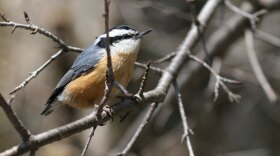-
For the casual observer it can often be difficult to distinguish quaking aspen from paper birch. That topic came up in a conversation recently. A friend mentioned that he cannot comfortably differentiate the two species. Both species are medium sized trees with light bark, but once a person learns what to look for, differentiating the two can become quite easy.
-
On January 6, 1805, the men of the Lewis and Clark expedition trapped a fox that was apparently hanging around Fort Mandan. Russell Reid, in his book Lewis and Clark in North Dakota (1988) speculated it could have been a swift fox. Most North Dakotans are familiar with the red fox. But the swift fox, also known as kit fox or prairie fox? Not so much, if at all.
-
Snow is an interesting phenomenon: As a water droplet freezes, it forms a hexagonal lattice that resembles a stop sign, but of course with six sides instead of eight. The ice crystal may continue to grow if water vapor around it continues to condense and freeze on the surface. Eventually, it makes a snowflake.
-
If you feed the birds during the winter, you may notice some differences in the species visiting the feeders from year to year. Some species, such as chickadees, are consistent visitors. But other species, such as siskins, seem to vary considerably — and during some years they seem to show up en masse, indicating some sort of invasion or "irruption" — meaning a sudden change in the population density.
-
It is time to check the nighttime sky. That is because the Geminids Meteor Shower is on now. The Geminids are widely regarded as the best meteor shower of the year. It started on the seventh and will run to the seventeenth with the peak viewing period coming on the night of December 13 and early morning hours of the 14th.
-
Winter is here. And for many of us it is the time of year to just stay indoors, hit the couch, and forget about getting outdoors to enjoy nature until spring. But give some consideration to getting outdoors and enjoying some of what nature has to offer during the winter months.
-
What kinds of squirrels live around your home area? I am thinking of tree squirrels, not ground squirrels such as the flickertail. Three of the more common tree squirrels in North Dakota are the fox, eastern gray, and red.
-
If you are looking for some good reading on life in Dakota Territory from the 1860s, you might want to check out Military Life in Dakota by Philippe Regis De Trobriand. De Trobriand was in command of Fort Stevenson in Dakota Territory from 1867-1869. His journal covers a wide range of topics about his time at the fort, ranging from observations on the space and solitude, mosquitoes, bison, prairie fires, grasshoppers, northern lights, and food. Now with Thanksgiving coming up next week, his observations on food offer us some interesting food for thought.
-
Sometimes also called a specklebelly, the greater white-fronted goose nests in the far north of North America as well as Europe and Asia. They are gray-brown with a white rump. And as you might expect, they have a white forehead which also runs down along the sides of the beak, thus the common name white-fronted goose.
-
Have the boxelder bugs been bothering you this fall? They have been inspecting lots of homes in search of a nice warm place to spend the winter.
Play Live Radio
Next Up:
0:00
0:00
Available On Air Stations









